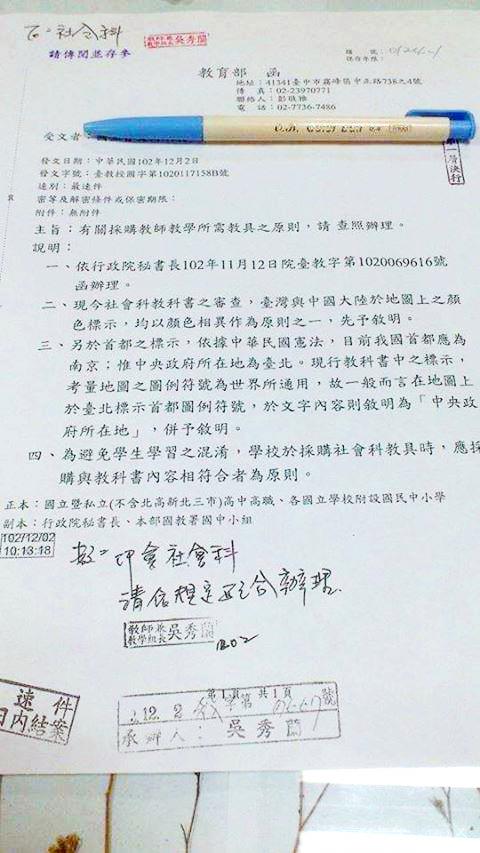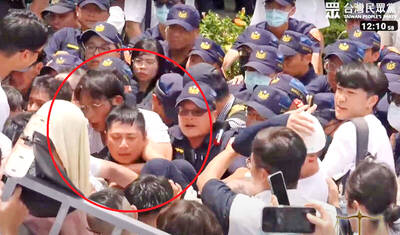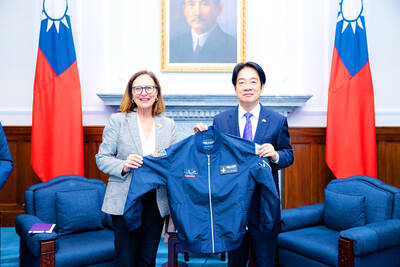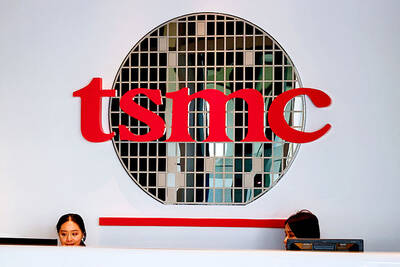A government document ordering schools’ procurement of teaching materials that mark Nanjing as the capital of the Republic of China (ROC) and Taipei as the current location of the central government indicated President Ma Ying-jeou’s (馬英九) administration’s persistent attempts to promote the links between Taiwan and China, as well as the administration’s misinterpretation of the Constitution, lawmakers and academics said yesterday.
A photograph posted by National Taipei University of Education professor Lee Hsiao-feng (李筱峰) on Facebook yesterday, which showed a Ministry of Education document issued on Monday to schools nationwide, went viral on the Internet.
“The document reflects the Ma administration’s ideology and its state of mind as a government-in-exile, which the majority of Taiwanese do not agree with. We should not be surprised because Ma has always tried to go against the trend,” Lee said.

Photo downloaded from Lee Hsiao-feng’s Facebook page
The professor said the photo was taken by one of his students, who is a teacher.
“Although Taiwan and mainland China have been marked with different colors in the textbook, Nanjing should be the ROC capital and Taipei is the current location of the central government, according to the ROC Constitution,” the document said.
Due to universal standards in map legends, Taipei would still be marked as the capital on the maps in teaching materials, but teachers are obligated to clearly explain the complexity of the situation to their students, the ministry said in the document, which was sent to high schools, vocational schools, junior-high schools and elementary schools across the country, except for those in Taipei, Greater Kaohsiung and New Taipei City (新北市).
Lee said that Ma has been trying to sinicize teaching materials, for example by insisting on referring to the period during which Taiwan was a Japanese colony as the “Japanese occupation period” in high-school textbooks.
Democratic Progressive Party (DPP) Legislator Lee Chun-yi (李俊俋) said the Constitution does not designate any city as the capital.
“Ma has been using the Constitution as a political tool to link Taiwan with China and to endorse his initiative of ‘one country, two regions.’ Everyone knows it’s nonsense and his interpretation of cross-strait relations is far from reality,” Lee Chun-yi said.
Under Ma’s leadership, government officials’ interpretation of the nation’s status has been “absurd,” he added, citing the example of Mongolian and Tibetan Commission Minister Tsai Yu-ling (蔡玉玲), who recently said that Mongolia remains ROC territory.
Ma has been inconsistent, DPP Legislator Chen Chi-mai (陳其邁) said, as he said he wanted to “make Taipei a world-class capital city” when he served as Taipei mayor.
The DPP administration between 2000 and 2008 reiterated that Taipei is the ROC capital, Chen said.
“Judging by a series of policy changes during the Ma administration, it has been engaging in a ‘de-Taiwanization campaign’ in an attempt to brainwash students and to force Ma’s ‘one China’ ideology upon young people,” Chen said.
Later yesterday, the ministry official in charge of the matter said he would take full administrative responsibility for not making the ministry’s intent clear in the document.
The head of the ministry’s K-12 Education Administration Division, Chiu Chien-kuo (邱乾國), said that during the Period of Political Tutelage (訓政時期), it had been mentioned that the capital of the nation was Nanjing, but there was no such mention in the Constitution after its ratification.
Since the implementation of the Act Governing Principles for Editing Geographical Educational Texts (地理教科書編審原則) in 1997, the guiding principle for all maps in geographical textbooks was that Taipei was to be marked as the capital with a label stating: “Location of Central Government,” Chiu said.
The part in the ministry’s document mentioning Nanjing did not provide a detailed explanation, for which he extended his apology, saying he was willing to assume responsibility for any administrative lapse, he added.
Additional reporting by staff writer

TPP RALLY: The clashes occurred near the Chiang Kai-shek Memorial Hall on Saturday at a rally to mark the anniversary of a raid on former TPP chairman Ko Wen-je People who clashed with police at a Taiwan People’s Party (TPP) rally in Taipei on Saturday would be referred to prosecutors for investigation, said the Ministry of the Interior, which oversees the National Police Agency. Taipei police had collected evidence of obstruction of public officials and coercion by “disorderly” demonstrators, as well as contraventions of the Assembly and Parade Act (集會遊行法), the ministry said in a statement on Sunday. It added that amid the “severe pushing and jostling” by some demonstrators, eight police officers were injured, including one who was sent to hospital after losing consciousness, allegedly due to heat stroke. The Taipei

NO LIVERPOOL TRIP: Taiwan’s Lin Yu-ting, who won a gold medal in the boxing at the Paris Olympics, was embroiled in controversy about her gender at that event Taiwanese boxer Lin Yu-ting (林郁婷) will not attend this year’s World Boxing Championships in Liverpool, England, due to a lack of response regarding her sex tests from the organizer, World Boxing. The national boxing association on Monday said that it had submitted all required tests to World Boxing, but had not received a response as of Monday, the departure day for the championships. It said the decision for Lin to skip the championships was made to protect its athletes, ensuring they would not travel to the UK without a guarantee of participation. Lin, who won a gold medal in the women’s 57kg boxing

‘NOT ALONE’: A Taiwan Strait war would disrupt global trade routes, and could spark a worldwide crisis, so a powerful US presence is needed as a deterrence, a US senator said US Senator Deb Fischer on Thursday urged her colleagues in the US Congress to deepen Washington’s cooperation with Taiwan and other Indo-Pacific partners to contain the global security threat from China. Fischer and other lawmakers recently returned from an official trip to the Indo-Pacific region, where they toured US military bases in Hawaii and Guam, and visited leaders, including President William Lai (賴清德). The trip underscored the reality that the world is undergoing turmoil, and maintaining a free and open Indo-Pacific region is crucial to the security interests of the US and its partners, she said. Her visit to Taiwan demonstrated ways the

The US has revoked Taiwan Semiconductor Manufacturing Co’s (TSMC, 台積電) authorization to freely ship essential gear to its main Chinese chipmaking base, potentially curtailing its production capabilities at that older-generation facility. American officials recently informed TSMC of their decision to end the Taiwanese chipmaker’s so-called validated end user (VEU) status for its Nanjing site. The action mirrors steps the US took to revoke VEU designations for China facilities owned by Samsung Electronics Co and SK Hynix Inc. The waivers are set to expire in about four months. “TSMC has received notification from the US Government that our VEU authorization for TSMC Nanjing